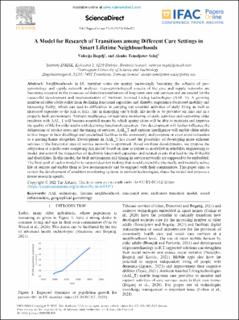| dc.contributor.author | Rogelj, Valerija | |
| dc.contributor.author | Temeljotov Salaj, Alenka | |
| dc.date.accessioned | 2023-02-02T12:12:05Z | |
| dc.date.available | 2023-02-02T12:12:05Z | |
| dc.date.created | 2022-11-02T16:12:15Z | |
| dc.date.issued | 2022 | |
| dc.identifier.citation | IFAC-PapersOnLine. 2022, 55 (10), 916-921. | en_US |
| dc.identifier.issn | 2405-8963 | |
| dc.identifier.uri | https://hdl.handle.net/11250/3047997 | |
| dc.description.abstract | Neighbourhoods in EU member states are ageing, increasingly becoming the subjects of geo-gerontology and supply network analyses. Geo-gerontological aspects of the care and supply networks are becoming essential in the processes of deinstitutionalisation of long-term care and services and are crucial for the successful development and implementation of Ambient Assisted Living technologies (AAL_T). A growing number of older adults suffer from declining functional capacities and, thereby, experience decreased mobility and increasing frailty, which can lead to difficulties in carrying out essential activities of daily living as well as increased exposure to the risk of falls. Aid in managing one's daily life needs to be provided on time and in a properly built environment. Ambient intelligence for real-time monitoring of daily activities and supporting older residents with AAL_T will become essential means by which ageing cities will be able to maintain and improve the quality of life for older adults with declining functional capacities. This development will further influence the delineation of service areas and the timing of services. AAL_T and ambient intelligence will enable older adults to live longer in their dwellings and specialised facilities in the community and postpone or even avoid relocation to a nursing home altogether. Development in AAL_T has raised the possibility of developing more efficient services if the functional area of service networks is optimised. Based on these developments, we propose the adaptation of a multi-state competing risk model based on time to failure as modelled in reliability engineering to model and control the trajectories of declining functional capacities and related events that lead to the ill-health and disabilities. In this model, the built environment and timing in service networks are supposed to be embedded. The final goal of such a model is to support decision making that would extend the physically and mentally active life of seniors and enable them to live autonomously and be engaged with their communities. This paper aims to review the development of condition monitoring systems in ambient technologies, shape the model and propose a future research agenda. Keywords: AAL technology; lifetime neighbourhood; functional area; multistate transition model; social infrastructure; geographical gerontology | en_US |
| dc.description.abstract | A Model for Research of Transitions among Different Care Settings in Smart Lifetime Neighborhoods | en_US |
| dc.language.iso | eng | en_US |
| dc.publisher | IFAC | en_US |
| dc.rights | Attribution-NonCommercial-NoDerivatives 4.0 Internasjonal | * |
| dc.rights.uri | http://creativecommons.org/licenses/by-nc-nd/4.0/deed.no | * |
| dc.title | A Model for Research of Transitions among Different Care Settings in Smart Lifetime Neighborhoods | en_US |
| dc.title.alternative | A Model for Research of Transitions among Different Care Settings in Smart Lifetime Neighborhoods | en_US |
| dc.type | Peer reviewed | en_US |
| dc.type | Journal article | en_US |
| dc.description.version | publishedVersion | en_US |
| dc.source.pagenumber | 916-921 | en_US |
| dc.source.volume | 55 | en_US |
| dc.source.journal | IFAC-PapersOnLine | en_US |
| dc.source.issue | 10 | en_US |
| dc.identifier.doi | 10.1016/j.ifacol.2022.09.419 | |
| dc.identifier.cristin | 2068237 | |
| cristin.ispublished | true | |
| cristin.fulltext | original | |
| cristin.qualitycode | 1 | |

